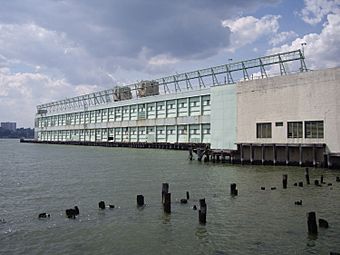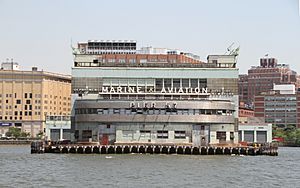Pier 57 facts for kids
Quick facts for kids |
|
|
Pier 57
|
|
 |
|
| Location | 25 Eleventh Avenue, New York, NY 10011 |
|---|---|
| Built | 1950-1954 |
| Architect | Emil Praeger |
| NRHP reference No. | 04000821 |
| Added to NRHP | August 11, 2004 |
Pier 57 is a large pier found on the Hudson River in New York City. It's on the west side of Manhattan. The pier first opened in December 1954. You can find it at the end of West 15th Street. It's near Eleventh Avenue and the West Side Highway. It sits just south of the Chelsea Piers sports complex. The pier started getting major updates and renovations in the early 2010s.
Contents
What Makes Pier 57 Special?
Pier 57 has two main levels above the water. It also has a concrete basement that rests right on the riverbed. The west end features a cool Art Deco-style metal design. It has stainless-steel signs that say "MARINE & AVIATION" and "PIER 57". The building at the east end is made of steel and brick. It has similar signs. Along the long sides, there are special "burton" cargo handling frames. These helped move goods easily on and off ships docked at the pier.
Floating Foundations: The Caissons
This pier is famous for its unique foundation. It rests on three huge, floating concrete caissons. These are like giant, hollow concrete boxes. Long steel beams stretch across these caissons, holding up the building above. The designer, Emil Praeger, had used similar floating structures before. He created temporary breakwaters for the D-Day invasion during World War II.
The caissons were built between 1951 and 1952. They were made in a special pond near Haverstraw, New York. Once finished, they were floated down the Hudson River to the pier's location. The two biggest caissons are about 360 feet long, 82 feet wide, and 33 feet high. The third one is 375 feet long and 25 feet high.
These caissons are very heavy, weighing up to 27,000 short tons. But they float because they push away more water than they weigh. This buoyancy supports 90% of the pier's weight. The riverbed supports the rest. These concrete boxes were sometimes called "Cheeseboxes" during construction. They are arranged in a T-shape. The caissons were placed on top of the old wooden piles from the previous pier. These piles were filled with sand and gravel.
Pier 57 was called "The World's Most Modern Pier" and the "Superpier." It was seen as a very new and smart design. It was fireproof and very strong. This helped avoid many problems that old wooden piers used to have.
A Look Back: Pier 57's History
Building the "Superpier"
Before the current Pier 57, there was an older wooden pier. It was also called Pier 57 and was built in 1907. In 1939, a company called Grace Line leased it. On September 29, 1947, a huge fire broke out at the wooden pier. It burned for several days. Over 200 firefighters and many fireboats, like the John J. Harvey, fought the blaze. The fire started in the wooden supports. It was thought to be caused by oil used to preserve the wood or fuel buildup. The fire caused about $5 million in damage.
Soon after the fire, plans for a new pier began. The concrete caisson supports were chosen to make the new pier fireproof. Construction started on August 30, 1950. By September 18, 1952, the three concrete boxes were in place. Building Pier 57 was the biggest dock project ever done by New York City at that time. During construction in 1953, a gasoline fire killed two workers and injured another. The total cost to build the pier was $12 million. The designers won a special award in 1955 for their clever design.
Pier 57's Working Life
The pier was officially opened on March 5, 1954, and started operating on December 29, 1954. Important people like Mayor Robert F. Wagner Jr. were there. The Grace Line started using the pier in March 1955. It served as a place to load, unload, and store cargo for the company. This new pier replaced the old wooden one. The Grace Line sold its shipping business in 1967.
From 1971 to 2003, Pier 57 was used as a bus depot. It was called the Hudson Pier Bus Depot for the New York City Transit Authority (NYCTA). The buses moved out in 2004.
About a year after the buses left, Pier 57 was used for a short time as a holding area. This happened during the 2004 Republican National Convention in 2004. Around 1,200 people protesting the event were arrested. They were taken to this temporary center at Pier 57. Some people called it "Guantanamo on the Hudson." People who helped with medical care reported that many held there had skin problems. These were from being exposed to old materials and conditions from its time as a bus garage.
New Life for the Pier
Because of its important design, Pier 57 was added to the New York State and National Registers of Historic Places in 2004. After the bus depot left, the pier was empty for a while. There were ideas to turn it into a sports complex or an Italian cultural center. However, these plans didn't work out.
In 2009, the Hudson River Park Trust chose a company called Youngwoo & Associates to update the pier. The new idea was called the SuperPier. It planned to have shops made from old shipping containers. The roof and the concrete basement area below the water would also be used. There would also be office spaces for new companies. Google has offices in the building. A food market by TV chef Anthony Bourdain was also planned, but it was canceled in late 2017.
The developers first thought the pier would open in spring 2017. But this was pushed back to 2018, then 2019. In October 2020, City Winery opened a large 32,000-square-foot space at Pier 57.
Images for kids
See also
 In Spanish: Muelle 57 para niños
In Spanish: Muelle 57 para niños




